 Brought to you by Franklin Pest Solutions Find helpful tips on preventing Fall Pests and more in this issue of the Pest Gazette! No time to read now? Franklin Pest Solutions Fall Gazette 2019!
Brought to you by Franklin Pest Solutions Find helpful tips on preventing Fall Pests and more in this issue of the Pest Gazette! No time to read now? Franklin Pest Solutions Fall Gazette 2019!
No More Fleas, Please
Fleas can be a nuisance and problem any time of year but especially as the cooler weather sets  in. This makes them one of the worst fall pests to invade our homes. Fleas can be brought into your home on cats, dogs or even rodents who are trying to find a warm place to spend the winter months. Fleas are small, typically one sixteenth of in an inch, reddish brown, wingless, blood-sucking insects. Their bodies are laterally compressed, (i.e., flattened side-to-side) permitting ease of movement through the hairs on their host’s body. Their legs are long and well adapted for jumping and the mouth parts of an adult flea are adapted for sucking blood from a host. The female adult needs a blood meal prior to laying her eggs. Much of the flea problem associated with pets has been eliminated by properly applying products offered by veterinarians to pet owners. However, fleas are still out there and doing well in wildlife and rodent populations. Other pests like bed bugs, lice and mosquitoes may cause bites within a home, and therefore it is good to have a proper inspection and identification of the infestation. We recommend you give us a call so that we can provide suggestions and treatments to eliminate your flea and blood sucking pest problems as well as other fall pests. •
in. This makes them one of the worst fall pests to invade our homes. Fleas can be brought into your home on cats, dogs or even rodents who are trying to find a warm place to spend the winter months. Fleas are small, typically one sixteenth of in an inch, reddish brown, wingless, blood-sucking insects. Their bodies are laterally compressed, (i.e., flattened side-to-side) permitting ease of movement through the hairs on their host’s body. Their legs are long and well adapted for jumping and the mouth parts of an adult flea are adapted for sucking blood from a host. The female adult needs a blood meal prior to laying her eggs. Much of the flea problem associated with pets has been eliminated by properly applying products offered by veterinarians to pet owners. However, fleas are still out there and doing well in wildlife and rodent populations. Other pests like bed bugs, lice and mosquitoes may cause bites within a home, and therefore it is good to have a proper inspection and identification of the infestation. We recommend you give us a call so that we can provide suggestions and treatments to eliminate your flea and blood sucking pest problems as well as other fall pests. •
Why Pest Control is Important
Fall pests pose multiple threats to human health and property. Rodents can spread disease and also contaminate food with their body hair and excrement. One estimate suggests that more than 20% of the world’s food is contaminated by rats and mice every year. Not only do rodents spread disease and contaminate food, but their sharp 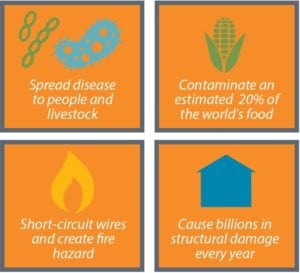
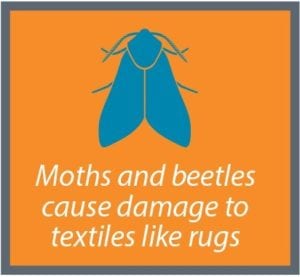
What’s that smell?!
Having stink bugs in your home can, quite literally, stink. Stink bugs get their name from the fact that they produce a foul smelling odor when they are disturbed or crushed.

Studio shot of a young woman holding her nose isolated on white
While stink bugs have long been considered fall pests and occasional invaders in homes and gardens, the accidental introduction of the brown marmorated stink bug into the eastern U.S. in the 1990’s has given homeowners additional cause for concern. Today, this pest can be found from coast to coast. The brown marmorated stink bug has a shield-shaped body that is typical of other stink bugs. Adults are about one-half of an inch long with a brown marble-like exoskeleton. This insect becomes a nuisance pest both indoors and outdoors when it is attracted to homes on warm fall days in search of protected overwintering sites. Stink bugs do not do any structural damage to homes, and they do not sting or bite. However, their presence can be quite apparent if they are squashed or disturbed, causing them to produce their foul smelling odor.
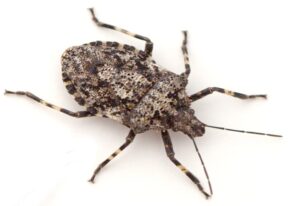
Rough Stink Bugs (Brochymena arborea) on a white background
As air temperatures begin to warm in early spring, adult brown marmorated stink bugs emerge from their overwintering locations in search of a mate. Females then find fruit trees to lay their eggs and die soon after. Beginning in May, nymphs emerge from eggs and feed on the fruit trees for a few months. By midsummer, nymphs have molted into adults and disperse to new feeding locations. The search for an ideal hibernation site such as an attic or wall void peaks in late October, and by November the stink bugs stop flying and settle into the chosen hibernation site for the winter. An effective method for managing fall pests, and specifically, the brown marmorated stink bug is to prevent these smelly insects from ever making it into your home in the first place. This is accomplished through various methods of exclusion. First, check all doors and windows to make sure they seal properly. Also, ensure that all screens are installed correctly and that they are in good working order. Next, check for cracks in areas such as siding, utility pipes, and behind chimneys that could give pests easy access to your home. It is important that the appropriate products are used to seal interior or exterior access points, otherwise exclusion methods may fail allowing pests to freely enter the home. Make sure to contact your trained pest management professional who is equipped to inspect and correct these issues using appropriate exclusion methods. If stink bugs have already made their way into your home, the point of entry must be found and sealed to prevent more insects from gaining access. Additionally, professional grade pest control products can provide relief from exterior and interior infestations. If you find brown marmorated stink bugs in or around your home, contact us to determine the best management plan for keeping your home free of stink bugs this fall. •
Identifying Hot Spots Around Your Home
In many parts of the country, the cooling temperatures of fall force chilly critters to start looking for winter shelter. Unfortunately, your warm, cozy home also looks inviting to insects and animals seeking a comfy place to stay for the winter.
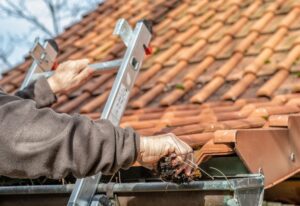
Man on a ladder cleaning house gutters
There are a few things you can do to help keep fall pests out of your home when temperatures begin to drop.
- As you walk around the outside of your home, look for signs of burrowing near the foundation or under decks. This could indicate a possible rodent or wildlife infestation.
- Be sure to keep garage doors closed, especially after dusk. Open garage doors allow mice, rats, and wildlife into the garage.
- Store pet food and birdseed in plastic bins with tightly fitted tops.
- Keep all garbage in closed containers both inside and outside the house.
- Seal any holes in the foundation or anywhere insects or rodents might enter. Silicone caulk or sealants work great for closing up minor gaps, especially around AC lines. Do not use expandable foam because it can degrade over time and it is easy for mice and other rodents to gnaw right through it.
- Add weather-stripping under doors to save energy and to exclude pests.
- Trim away any trees which have branches in contact with the house as ants and even wildlife love to use these to find a way into our warm homes.
- Clean debris from gutters so rainwater flows freely.
- Make sure that you have a chimney cap properly installed to prevent birds, rodents and wildlife from entering. Many dampers are not airtight, so there is often a nice, warm air current going up the chimney which makes things very cozy for these pests.
- Look for any wood in contact with the soil near the house. This can lead to a termite infestation.
These steps can certainly help reduce pests from getting in, but unfortunately, sealing all potential openings can be a daunting task. We can help you with preventative treatments. Call us for an appointment today! •
Prepare for Cluster Flies Before Winter
Many people mistake cluster flies for house flies. However, the big give away is the time of year that you will encounter cluster flies- in winter. House flies are going to be more prominent in warmer months, in late spring and throughout the summer into early fall. Cluster flies will begin to move indoors in autumn when temperatures begin dropping and will spend their winters indoors during the cold months. On a warm, sunny day in winter, you may encounter a cluster fly clumsily flying around your home or window. You may find a large population of flies clustered together in an attic or wall void, indicating that you have a cluster fly infestation. They will emerge in the spring, exiting the house to go lay eggs in the soil and start a new generation of flies.
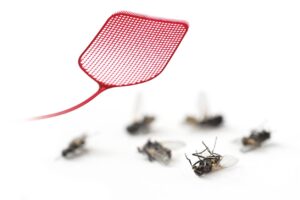
red flyswatter and dead flies isolated on a white background, copy space, macro shot, selected focus, narrow depth of field (red flyswatter and dead flies isolated on a white background, copy space, macro shot, selected focus, narrow depth of field,
Preparing your home prior to winter is the best option for fall pest and cluster fly control. Once they become established, they may be difficult to access in your home for control. Excluding cluster flies from entry should help prevent cluster flies from becoming an issue in your home. Entry points should be concealed, especially near soffit or ridge vents. Additional protection via insecticides may also be helpful when applied by a pest management professional in appropriate spaces that flies contact. If you are interested in excluding or treating for cluster flies, feel free to give us a call. •

